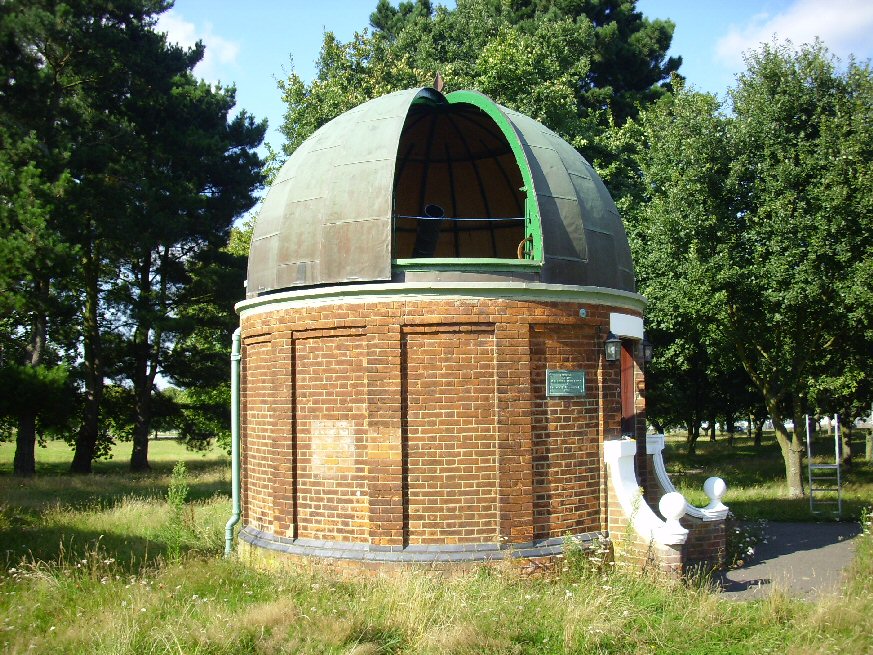
The observatory, a red circular brick building with a hemispherical dome, has stood for many years as a listed building in the centre of Aldershot army garrison, home to the British Army.
Image credit: Farnham AS
After redevelopment the observatory building now stands on a paved area outside a primary school but is no less accessible.
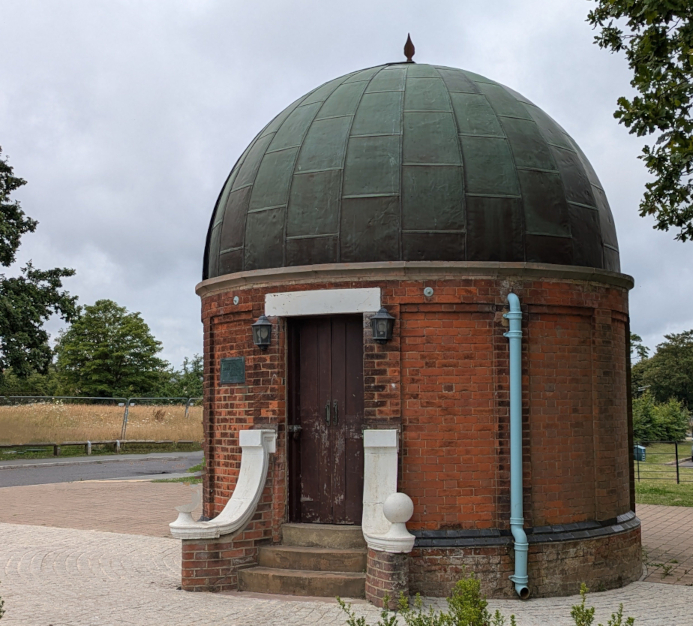
Inside the building is a 8-inch cell refractor telescope mounted on an equatorial pillar with counterweight clockwork drive, built in 1891 by the famous Sir Howard Grubb of Dublin. Both telescope and dome were designed and constructed in Dublin, Grubb being makers of the largest and best known optical telescopes in the world at the time.
Image credit: Danny Thomas
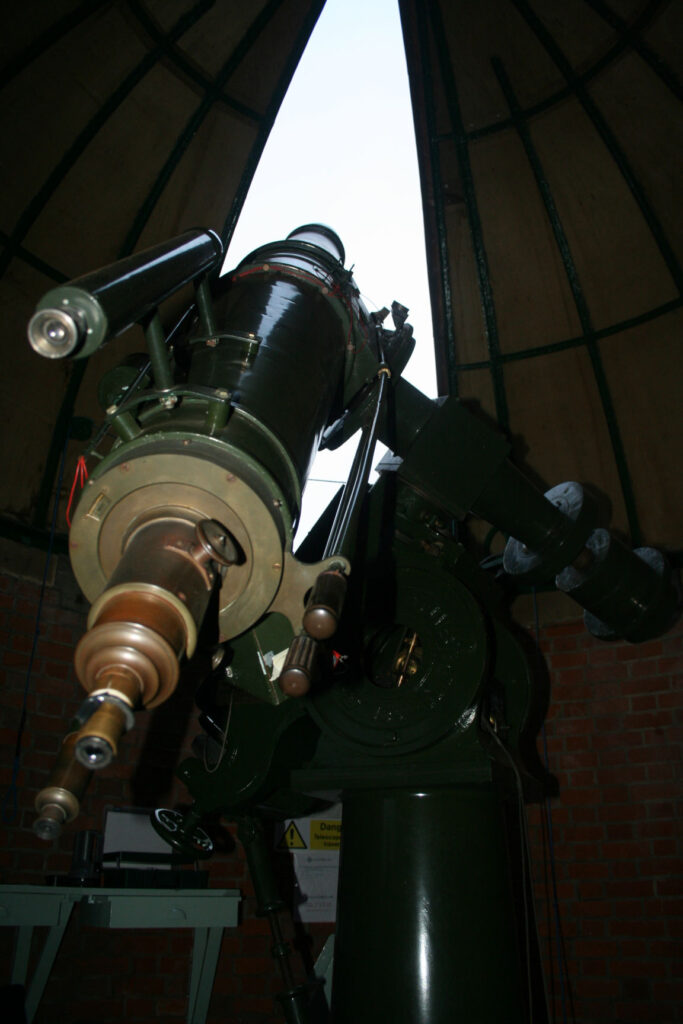
| OG diameter: | 8.0 inches |
| Focal Length: | 10 ft |
| Focal Ratio: | F15 |
| Min Elevation: | 15 degree above horizon |
| Latitude: | 51º 15’’ 30.3″ North |
| Longitude: | 0º 45’’ 44.2″ West |
| Altitude: | 90 Metres above sea level. |
The circular red brick building was constructed by local trade services and Patrick Y Alexander donated the funds, telescope and observatory to the army. Further information on Patrick Y Alexander can be found in a biography written by Gordon Cullingham. Publisher CROSS MANUFACTURING, bath, England. ISBN:095091600. (updated:231000). For further information about the Aldershot Observatory please contact Eric Grieve: (see below)
Visiting the Observatory
Visits to the observatory are by arrangement.
Observatory History
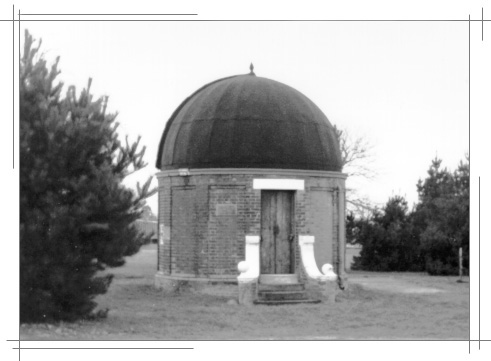
It was not known whether Alexander used the telescope for any other purpose, but he became a member of the Royal Astronomical Society in 1921. The telescope was probably a scientific toy used to show distinguished visitors, for Alexander was a professional balloonist with some outstanding feats and record ascents to his name. In 1902 Alexander offered the telescope to the city of Bath, with all expenses paid to build an observatory, but Bath refused on the grounds that it would attract a charge upon the rates. The telescope was later dismantled and stored at Mr Braham shop in Bath, until a new location was found for it to be sited.
Between 1903-1904 Patrick Alexander moved residence to Mychett, Surrey, where he was involved with the Army Balloon section and early aviation with Samuel Cody, Aldershot. Both lived at the same address at one time or another, an historical plaque at the current residence address has both their names inscribed. It was known that the telescope was erected and housed at this residence within the grounds above a garage building. In 1905 Alexander wrote to the War office offering the donation of the telescope with the same conditions made to Bath, the offer was accepted and a site was chosen. In December 1906 the observatory was officially opened, attended by several high ranking officials and guests from Aldershot civic council, and Alexander himselfOver the years military and civilian personnel used the observatory, and one time an offer was made to move the telescope to a more secure site within a research establishment, where it would be maintained and used more frequently. The offer was not accepted by the army camp commandant at the time and hence the observatory has remained within Aldershot garrison. The dome was originally of rubberoid material (SIC) but perished over time, causing weather to enter. Later the telescope was dismantled and the dome was rebuilt with metal cladding.
Notably the most important event in the history of the Aldershot observatory was the astronomical event and discovery of the ‘white spot’ on Saturn, by an amateur astronomer, John Pettley. It was on one night in August 1933, observing through the Aldershot telescope that Pettley recorded the shape and size of the white spot. Pettley reported the event to Greenwich, but they were clouded over and could not confirm his sighting. The following day an article appeared in the ‘Daily Express’, that the actor Will Hay, also an avid astronomer, discovers white spot on Saturn. Later several articles appeared in the ‘English Mechanic’ submitted by Pettley, mentioning the Aldershot telescope and event. Local amateur astronomers and societies have since used the observatory, but obstruction of clear views and light pollution has seen a decline in its use and local interest over the years.
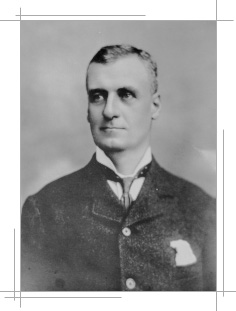
Patrick was first introduced to aeronautics when he was taken as a boy to see the Paris Exhibition of 1878. Patrick and his father made their first balloon ascent in a Henry Gifford balloon. For the next 30+ years Patrick Alexander devoted his life in designing, building and studying flying machines. His life ambition was to be the first man to fly a heavier than air machine. Between 1891 to 1900 Patrick Alexander had made several balloon ascents. He was one of a few people who owned and flew balloons, the ‘Majestic’ being his largest. Patrick also hosted the Centenary Ascent from Sydney Gardens, Bath on 8th September 1902. Commemorating Andre-Jacques Garnerin ascent of 1802. It was attended by Major Baden-Powell, Hon. C.S. Rolls, Major F. Trollope, Dr F.A.Barton, Capt. Templer, Col. Capper, Augustus Gaudron, Samuel F.Cody and other distinguished guests. All of which were close friends of Patrick Alexander.
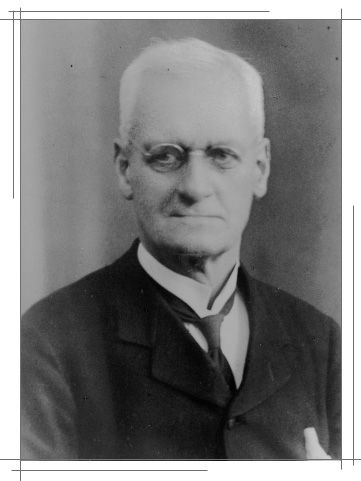
Patrick Alexander was respected by fellow aeronautical pioneers and close friends, such as eminent people as Octave Chanute, Wilbur and Orville Wright, Santos-Dumont, Lawrence Hargreaves, Louis Bleriot, Henri Farman, Count Zeppelin to name only a few, as well as head of states and royalty in Europe. Patrick Alexander a world traveler, would arranged meetings with aeronautical people and gave lectures on the development and progress being made in aviation around the world.
Sadly at the age of fifty, his inheritance gone, Patrick Alexander spent the remainder of his life at the United Services College, Windsor. Where he taught students the basic principles of aeronautics. He would also hold model flying competitions for the students in the park, watched by the Eton College boys. A young apprenticed carpenter boy, who lived in the same road as Patrick Alexander, started the ‘Windsor Model Aircraft Club’. The boy was very keen at making propellers and testing them on model airplanes he built and flew in the park. The boy later became to be known the designer of the ‘Hurricane fighter’, Sir Sidney Camm.
Restoration of the Observatory
In 1979 the observatory was closed because of corrosion in the dome mechanism. Lack of military funding, increased light pollution and other problems preventing clear views had caused a decline in its use, all resulted in the observatory becoming neglected. However after the Army carried out a major overhaul of the Observatory dome and telescope it was reopened in 1987. The local Royal Electrical and Mechanical Engineers (REME) workshops had been lead maintainers of the observatory. In 1998 a Farnham Astronomical Society member Barry Bellinger, working with the Army, oversaw further restoration of this wonderful telescope. The lens was found to be in a poor state and was reground by the Sinden Optical Company in April 2000. The use of this company also preserved an important connection with the origins of the telescope.
The Sinden optical Company was founded in 1979 by David Sinden, one of the world’s greatest authorities on optics and the last link with Grubb-Parsons in Newcastle upon Tyne where he was Chief Optician. As Chief Optician at Grubb Parsons he was responsible for some of the world’s largest optics, including the 4.2-metre mirror for the William Herschel Telescope, the 3.9-metre mirror for the Anglo-Australian Telescope, and the new corrector plate for the 48-inch Oschin Schmidt at Mount Palomar. He continued to produce high-quality optics ranging from standard-aperture mirrors for amateurs to a 40-inch mirror for a Japanese observatory.
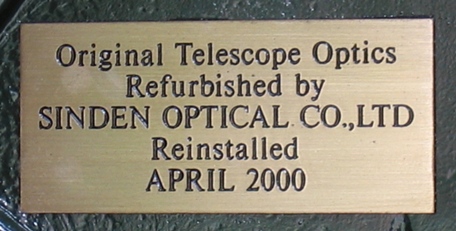
David Sinden died on 29th August 2005.
A Very Brief History of the Grubb Telescope Company
The Grubb telescope housed under the dome of the Aldershot Observatory has a very distinguished pedigree.
Thomas Grubb (1800 – 1878) began making scientific instruments in the 1830s and quickly gained a name in the construction of telescopes. The Grubb Telescope Company was founded in 1833, its factory was near Charlemont Bridge, Dublin. Thomas was an innovator in both telescope making and in optical design. The Markree telescope in County Sligo in the West of Ireland, one of his earliest telescopes, was built in 1834 and was at that time the largest telescope in the world. In 1835 the Markree Telescope was used to sketch Halley’s comet and to view the solar eclipse of 15 May 1836. As early as the 1840s Grubb was constructing mirrors for refractors up to 15 inches in diameter. His notable contributions included construction of the Great Melbourne Telescope; for several decades this was the largest equatorially mounted instrument and dwarfed only by the Earl of Rosse’s “Birr Leviathan”. Sadly, the Melbourne telescope was destroyed in the Mount Stromlo fire of 2003. The quality of Grubbs telescopes is revealed by the following (from ‘The Great Telescope of the Earl of Rosse’, Dublin Literary Journal, 1845)
“Sir William Herschel yielded to the difficulty making his large four feet speculum of proportions of the metals and diverged considerably from the rule which rendered his labours comparatively useless Although this alteration rendered the casting of his metal much easier in every way yet of three attempts to produce a perfect speculum two entirely failed So difficult is it to succeed in this operation that no English optician wishes to engage in preparing one of even nine inches in diameter However our distinguished countryman Thomas Grubb present engineer lo the Bank of Ireland able to complete one of fifteen inches in most perfect manner Thus distant as we are from the great central fields of science Ireland has assumed the first rank in astronomical mechanics”
In 1864 Thomas was joined by his son Howard (1844-1931 who continued to develop the company’s reputation for quality optical instruments. Grubb’s workshop on Observatory Lane, Rathmines Road constructed some of the worlds largest and best engineered telescopes in their day. The Grubb optical works in Rathmines serviced initially the needs of the Armagh observatory and later of the giant Birr telescope. Howard became a Fellow of the Royal Society in 1864, and received a knighthood in 1887.
Contracts for large telescopes began to dry up in the later part of the nineteenth century and during the First World War Howard Grubb began making periscopes for submarines. This became the company’s primary business until the end of the 1st World War in 1918. After the war the company gradually slid into decline and produced only a few telescopes. In 1918 the Dublin Works was moved to St Albans, Herts. It was saved from bankruptcy in 1925 by Sir Charles Parsons when, on Howard Grubb’s retirement, he bought out the optical shop (Charles Parsons was the inventor of the first practical steam turbine and son of William Parsons, the Third Earl of Rosse, and who built the “Birr Leviathan”). Parsons built a new works at Walkergate, Newcastle and continued to construct the highest quality telescopes until 1985. It designed and built the optical components for telescopes such as the Anglo-Australian Telescope, UK Infrared Telescope and the Isaac Newton Telescope, astronomical instruments which continue to make important contributions to our understanding of the universe. The last telescope manufactured by Grubb Parsons was the 4.2m William Herschel Telescope on La Palma in the Canary Isles.
A list of telescopes manufactured by Thomas and Howerd Grubb is maintained on the South African Astronomical Observatory (SAAO) web site.
Thomas Grubb is buried in Mount Jerome Cemetery, Dublin, Ireland.
Mar 2018
